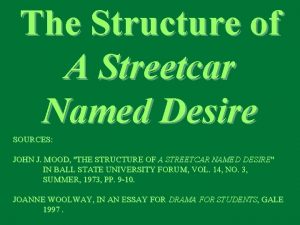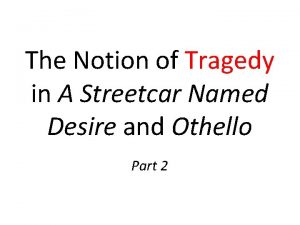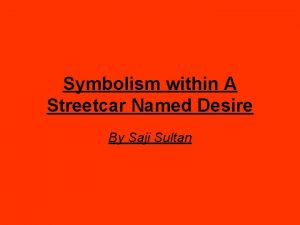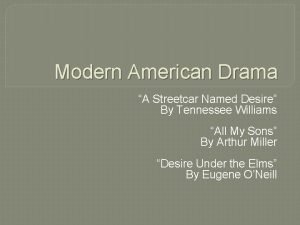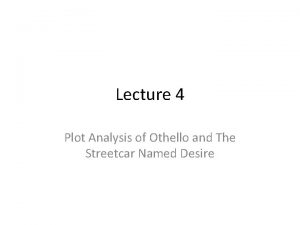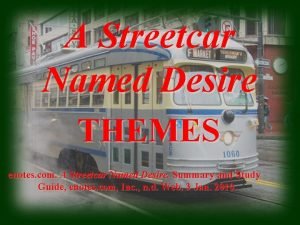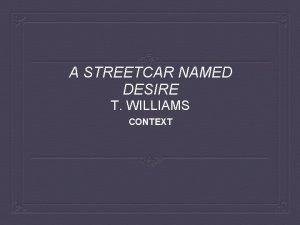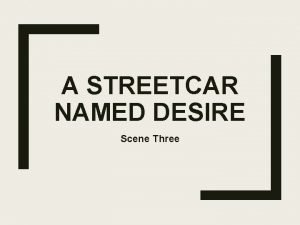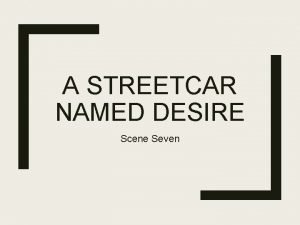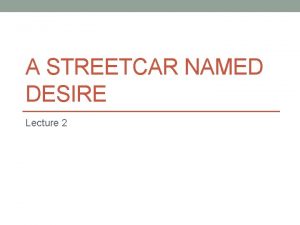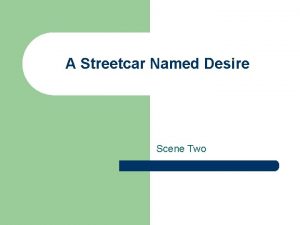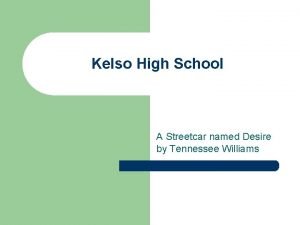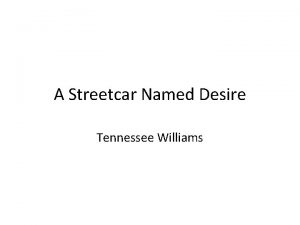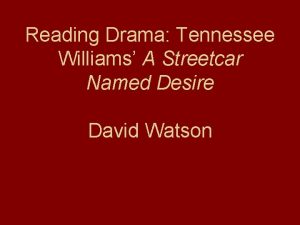The Structure of A Streetcar Named Desire SOURCES













- Slides: 13

The Structure of A Streetcar Named Desire SOURCES: JOHN J. MOOD, ''THE STRUCTURE OF A STREETCAR NAMED DESIRE" IN BALL STATE UNIVERSITY FORUM, VOL. 14, NO. 3, SUMMER, 1973, PP. 9 -10. JOANNE WOOLWAY, IN AN ESSAY FOR DRAMA FOR STUDENTS, GALE 1997.

The play begins with a wellknown, enigmatic entrance speech by Blanche Dubois: BLANCHE [with faintly hysterical humor]: They told me to take a streetcar named Desire, and then transfer to one called Cemeteries and ride six blocks and then get off at—Elysian Fields!

These words are famous for their realistic and symbolic significance.

They may also be examined, however, as a clue to the structural development and design of the play itself and of Blanche’s fate and the course that her life takes in the drama.

The Statement Has 2 Parts • The first deals with the events of Blanche's life before the play opens ("take a street-car named Desire, and then transfer to one called Cemeteries") • The second deals with the play itself ("ride six blocks and then get off at —Elysian Fields").

• The allusion to Elysian Fields is from Virgil's Aeneid. • Williams used this as the name of the slum in New Orleans, "Elysian Fields. ” • In Virgil's poem this is the place where the dead were made to drink water from the river Lethe to forget all traces of their mortal past. • Both Blanche's drinking and her endless hot baths suggest that she is attempting to wash away her past and emerge through a sort of watery purgatory.

• During the play, the audience learns that Blanche had symbolically taken the “streetcar named Desire, ” and had “transferred” to the one called “Cemeteries. ” • We learn about Blanche’s youthful loving desire… “When I was sixteen, I made the discovery—love. All at once and much, much too completely. It was like you suddenly turned a blinding light on something that had always been half in shadow, that's how it struck the world for me. ” • This is about her love for Allen Grey, whom she calls her “boy” husband.

What is unique about Blanche’s “loving desire? ” • To her, it is the kind of love that lights up the world. • But a traumatic event twists Blanche's loving desire into hate and self-loathing. • She discovers her young husband's homosexuality and her shocked, brutal words to him result in his suicide ["I saw! I know! You disgust me. . . "]. • Thus her loving desire becomes brutal desire, unloving desire. • Blanche, in short, has “transferred” to the streetcar named “Cemeteries. ”

At that point in Blanche's life, the play begins. • She can continue her course on the streetcar called Cemeteries toward the final death—or obtain heavenly bliss. And the latter will take six blocks. • Then Blanche and Mitch have a moment of tenderness at the end of their first date. • Blanche confesses to Mitch (and to the audience) the ugly story of how she destroyed her young husband.

• This moment of honesty elicits further kindness and even the beginning of love from Mitch: "You need somebody. And I need somebody, too. Could it be—you and me, Blanche? " And Blanche, "in long, grateful sobs" replies: "Sometimes—there's God—so quickly!“ • Thus, at the end of the sixth scene, the sixth block on her ride of death, Blanche indeed is on the threshold of finding "God, " "Elysian Fields, " loving desire. • At that point, she has life within her grasp. It is the turning point of the play.

• But the opportunity passes. • The very next scene quickly demonstrates that Blanche has resumed her illusions and games with Mitch, and thus her chance for life is lost. • If Blanche and Mitch had been more open with each other and more willing to be vulnerable in each others’ confidence (in other words, if they had developed a loving relationship), maybe Stanley would never have raped Blanche. • Maybe Stanley would have respected the “boundary” established by his friend Mitch and that respect might have extended to Blanche.

Flores Para Los Muertes • Near the end of the play, the deadly fate is made explicit. • The Mexican Woman appears, chanting her wares: "Flores? Flores para los muertes? " (Flowers? Flowers for the dead? ) • Blanche dimly realizes that she is “dead. ” • …that she is still on the streetcar called Cemeteries • …that she has missed the stop at Elysian Fields • …that she is doomed to sterile, dead lust

• In a kind of real recognition, she says in response to the old woman: "Death—. . The opposite is desire. ” • She has dimly realized that desire is the opposite of death, and that this desire which is the opposite of death is open, honest, forgiving, loving desire, the kind Stanley and Stella have for each other. • The most that Blanche can expect now is ''Kindness. " Remember her dependence upon the “kindness of strangers. ” • All that remains for her is her final tragic collapse.
 Structure of streetcar named desire
Structure of streetcar named desire How is blanche a tragic hero
How is blanche a tragic hero Streetcar named desire symbolism
Streetcar named desire symbolism Stagecraft in a streetcar named desire
Stagecraft in a streetcar named desire Tennessee williams plastic theatre
Tennessee williams plastic theatre Expressionism in a streetcar named desire
Expressionism in a streetcar named desire Plot of othello in short
Plot of othello in short Streetcar named desire themes
Streetcar named desire themes Tennessee williams context
Tennessee williams context Plastic theatre in a streetcar named desire scene 3
Plastic theatre in a streetcar named desire scene 3 A streetcar named desire scene 7
A streetcar named desire scene 7 A streetcar named desire setting scene 1
A streetcar named desire setting scene 1 A streetcar named desire scene 5
A streetcar named desire scene 5 A streetcar named desire american dream
A streetcar named desire american dream
